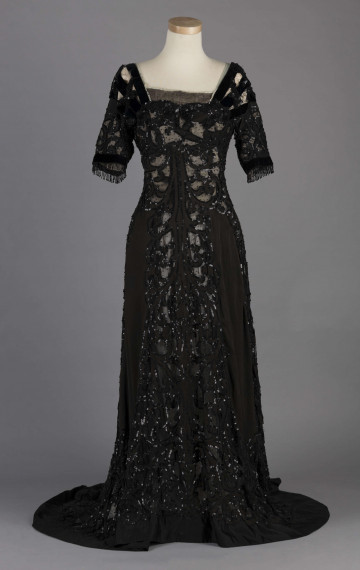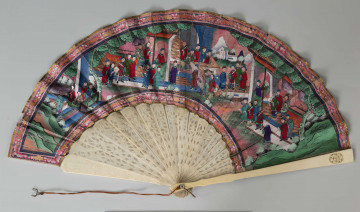
Formal gown
1895 — 1900
National Museum in Lublin
Part of the collection: Textiles, embroideries, clothing and costume accessories
With its exotic and amazing art, the distant, mysterious country that China appeared to be has been an object of interest for Europeans for centuries. The few Chinese products that appeared in Europe as early as the Middle Ages fuelled curiosity. Porcelain and various silk fabrics were imported with considerable difficulty. In the 19th century, interest in the Orient blossomed again and influenced many areas of European culture. The increasing ease of travel and development of the fashion for tourism favoured the collection of exotic and oriental objects, often as souvenirs from travels. A response to the phenomenon was the manufacture of products in line with the tastes of Europeans. The Chinese dress can be an example. It was brought to Poland as probably the home dress of an elegant woman living at the turn of the 19th and 20th centuries. The dress has an official cut, characteristic of court fashion during the reign of the Manchu dynasty (1644-1911). Men's and women's robes at that time had the same cut. They differed in decoration and colour. Women's robes were decorated with embroidered motifs of flowers and birds.
The festive character of the costume is emphasised by the richness of the colourful embroidered ornaments with a recurring phoenix motif. The mythical bird symbolising splendour and high ethical values was supposed to appear on earth only when a noble and reasonable ruler reigned there. The peach blossom sprigs embroidered on the edges of the dress are a symbol of longevity, and the peony, considered the queen of flowers, embodies feminine beauty and grace. The dress is made of pink amaranth, which was not one of the five traditional colours for damask. It would indicate the unofficial nature of the garment.
Thus, two possibilities are open: it was an everyday dress of a wealthy Chinese woman, or it was intended for a European audience. The pastel Portrait of a Woman in a Chinese Wedding Dress 'longpao' by Teodor Axentowicz and Leon Wyczółkowski's self-portrait in a Chinese semi-official male dress 'longpao' confirm the popularity of Chinese costume also in Poland.
Magdalena Norkowska
Author / creator
Dimensions
cały obiekt: height: 125 cm, width: 137 cm
Object type
item of clothing
Technique
applique
Material
silk, silk thread, silk satin
Creation time / dating
Creation / finding place
Owner
The National Museum in Lublin
Identification number
Location / status

1895 — 1900
National Museum in Lublin

1850 — 1900
National Museum in Lublin

1920-1950
National Museum in Lublin
DISCOVER this TOPIC
National Museum in Lublin
DISCOVER this PATH
Educational path